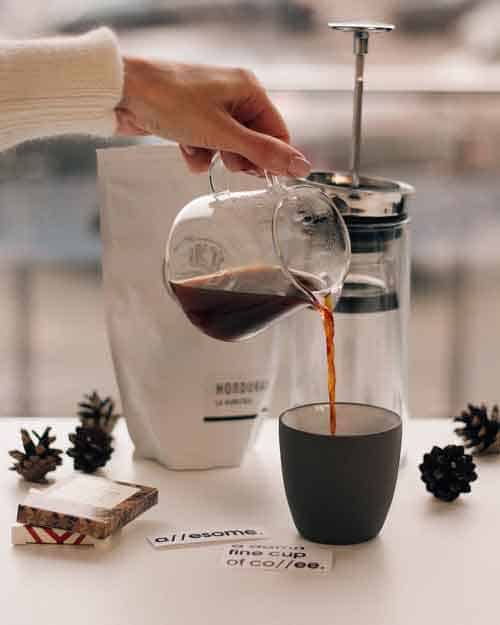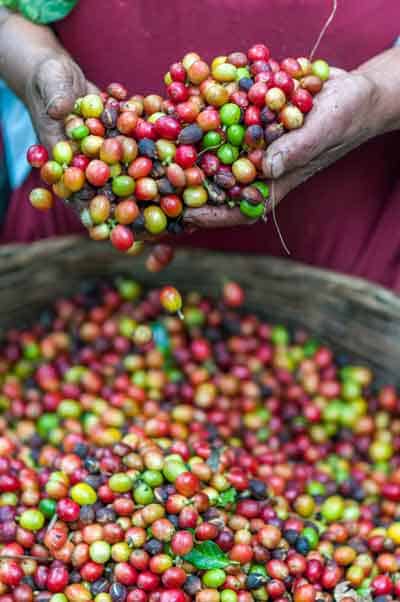Aficionados and purists distinguish between “flavors” and “flavor notes” when judging coffee. It’s a hard distinction for the average “Joe” (pun intended), but here goes.
Flavor in coffee is a complex mixture of taste, mouthfeel and aroma mixed in with the more delicate flavors. Your senses may get overwhelmed unless your palate is trained to separate out the 800 or more aromatic compounds found in coffee (Overwhelming, right? By comparison, a good wine will have 500 or so). So, think of what you smell when you walk into a good barista, or when your favorite coffee is being brewed. Some coffees leave aromas dangling for an hour or more. That’s what hits you first, along with the taste on the tongue.

Flavor notes are the more delicate flavors that are buried beneath the surface – you could call it aftertaste or some other name, but you should know what it means when you drink a good medium roasted coffee. These are the subtle fruity, nutty, or wine notes, over and above the sweetness, brightness, chocolatey, or other major flavors, that take you back to where the coffee was grown, the essence of the soil, and the climate.
As experts note, flavor in coffee comes from the trees themselves … everything done to harvest, process, roast and brew is, or should be, an attempt to preserve as much of that flavor as possible. Let’s see how.
Typical Flavor Notes Found When Tasting Coffee
There are primary, secondary and tertiary flavors in coffee. The table below captures some the main flavor categories, going into secondary notes alongside each:

- Chocolate: This is a basic, strong flavor – the choices under tend to range from bittersweet to milk chocolate.
- Sweet & Sugary: This is a basic, strong flavor – the subtler notes include honey, vanilla, butter, cream, maple syrup, and brown sugar, among other variations.
- Nuts: Nutty flavors usually occur in high altitude coffees grown on volcanic soil – the subtler notes include walnut, almonds, pecan, peanuts, and hazelnut.
- Vegan/Earthy/Herb Flavors: These could simply be earthy when from Central America (for example), but a wide variety of subtle flavor notes, from black tea, green tea, and mints, to leafy greens, tomatoes, carrots, sweet peas, and mushrooms; to cedar, tobacco, and straw, are possible – along with many others.
- Roast Induced Flavors: Roasting coffee brings out smoky and woody flavors, along with burnt sugar and carbon.
- Grains & Cereals: Certain coffee beans pick up flavors from the soil and environment which are similar to crops from the region – could range from wheat, rye, barley, and maize, to more subtle flavors such as toasted dates and graham crackers.
- Fruits: This is possibly the widest range of flavor notes that can be present in coffees from various regions, soils, and elevations. The main types are Tropical Fruit, Citrus, Apple/Pear, Melon, Grape, Stone Fruit, Berries, and Grape Fruit. Under each of these categories are a vast array of fruits, possibly 30 to 40 in all that have been classified.
- Floral: There are many distinct floral notes that are found, ranging from hibiscus, rose, magnolia, honeysuckle, and lavender to one side, to lemongrass and orange blossom on the other.
- Savory & Spicy: A wide range of savory (sundried tomato, soy sauce, and meaty) and spicy (clove, anise, cumin, nutmeg, ginger, coriander, and white or black pepper) can often be present as flavor notes.
What Affects The Flavor Of Coffee?
There are several factors that affect the flavor, both the bold, upfront texture as well as the subtler notes. Let’s consider a few of them, keeping in mind the general principle that the flavor comes from the environment where the coffee beans are grown. It must be preserved through all the subsequent processing before it reaches your cup and lips.
- Varietals: There are four main varietals of coffee. Most of the better flavors come from Arabica beans, which represent 60% of the higher-grade coffees sold around the world. Robusta beans, which make up the majority of the rest, are considered to be lower grade commodity coffee, which is often blended, used in coffee-flavored drinks with other ingredients (e.g. cheaper Mexican Coffees) and may even have artificial flavors infused in them (yes, those do exist!). However, there are interesting sub-varietals with distinct taste and flavor, such as Bourbon (Called the pinot noir of coffees for its rich taste and texture, sweet with chocolate and nutty flavors), Colombia (Classic Caramel and Chocolate taste, sweet, bright & full-bodied with cherry notes), Pacamara (Wonderful highland flavors of sweet citrus with floral notes), Gesha (Completely different flavor closer to black tea, with notes of bergamot) and Jember (Subtle notes of maple syrup and brown sugar, with a hint of caramel), to name just a few.
- Ripeness: As with any fruit, the coffee cherries will develop and yield more flavor as they ripen. Really young green coffee beans do not amount to much.
- Soil: Coffee growing soil needs to be fertile but must drain well – water retention at the root level is harmful. Sandy loam is considered one of the ideal types. The next part is the minerals. Volcanic soils from Guatemala, Indonesia, or Ethiopia have a rich mixture of potassium, calcium, phosphorous, nitrogen, boron, and zinc, all important minerals that help nurture the plants and impart flavor.
- Elevation: Coffee grows better at higher altitude rainforests. Regions that have high altitude cultivation between 3000-7000 feet above sea level, with adequate sunshine, will develop some of the best flavors. Plants grow slowly in such climates and are forced to focus more on bean production. This creates the sugars that give the coffee bean their delicious flavors.
- Climate (Temperature, Sunshine, Rainfall): Most coffee growing regions that produce rich flavors of coffee have adequate rainfall, that is, 60-80 inches a year. Temperatures range from 600 to 900 Fahrenheit depending on the time of year. In general, most regions have tropical climates with plenty of sunshine.
- Processing: Coffee can be processed in three ways: wet, dry, and semi-washed. Wet washing tends to preserve many of the flavors of the original beans, but may not round or balance them out, while dry/natural processing will tend to push forward the fruity flavors at the expense of some of the heavier (e.g. chocolatey, sweet) flavors. The semi-wash or “honey” approach may present the best combination of preserving the original flavors but balancing them out properly.
- Drying: This needs to happen just right, as with anything else. Too fast, you effectively burn the beans, producing a charred wood/paper flavor. Too slow, the beans will taste faintly like wet mulch – moldy and musty.
- Roasting: Coffee roasted dark often times loses the majority of its subtler flavors, you have effectively charred the coffee beans. Lower roasts, at hot temperatures, tend to produce weak, acidic coffee. Medium roast coffees often produce the widest and most balanced range of flavors, with subtle notes and aftertastes, brightness and acidity.
- Packaging: Coffee that is packaged promptly after packaging, especially in small batches, sealed bags that can breathe, will typically retain its flavor longer than coffee left out after roasting, loosely packed, and/or left without ventilation.
- Storage: Coffee stored too long without a low temperature and sealed environment will eventually grow stale and develop a heavier texture and mouthfeel, with woody and musky flavors. Well stored coffee can last a year or more without substantial loss of flavor.
- Brewing: Coffee brewing is itself an art. Amount of water, temperature, pressure, the grind itself … each bit is important. A barista wielding an espresso machine skillfully will do more to bring out the flavors trapped within than one can possibly imagine.

As you can see, both the dominant flavors and aromas, as well as the subtler flavor notes, originate in the soil, climate and environment (called “terrior”) – there is good reason why higher altitudes provide better flavor. But the human intervention downstream is what allows certain flavors to be suppressed and others to be thrust forward. Over-roasting especially can kill a lot of flavor tones.
Coffee Flavor FAQ
Besides the discussion above, there may be some other Frequently Asked Questions. Let’s visit a few:
- Is Flavor the Main Thing You Should Look for?
As we discussed, the flavor is a combination of taste, flavor, and aroma. So, there’s not a “main thing” as such. However, better quality coffee beans (like high-grade Arabica with sub-varietals such as Pacamara) can bring forward unusual and subtle flavor notes that enrich your experience. Decide what suits your fancy. Then compare coffees to establish what you like.
- What Type of Roast Should Your Coffee Have?
You need to choose if you like French Roast or Dark Roast as a style, understanding that you are sacrificing subtleties of flavor except for some woodier dark tastes such as chocolate. Dark Roasts have less acidity and are an acquired taste. Lower, hot roasts will tend to produce acidic coffee where it’s difficult to get all the flavors due to the weak body. Medium Roasts coffees typically have the most flavor notes in the fruit, citrus, floral and other, subtler notes.
- What is more important – flavor, acidity, brightness, mouthfeel … or balance?
If you like flavor, both bold and delicate, you will be best served with coffee beans that present a balanced flavor. Too much of one flavor or texture dominating will tend to kill the other, subtler flavors. You can choose a style that suits you, but variety is the spice of life … as they say. A well-balanced coffee allows you to enjoy many different flavors in the same cup.
- Which countries make the best coffee in terms of flavors?
It depends on what you like. As a rule of thumb, Ethiopian coffees tend to have a tea-like body, with pronounced fruity notes, Kenyan coffee, on the other hand, has grapefruit notes. Closer to home, Central American coffees (Guatemalan, some Mexican, especially Colombian and Brazilian) tend to be heavier, with nutty, buttery, and chocolatey flavors and some fruity notes. Indonesian coffees are earthy and smoky, right? But they have marked fruity notes in many instances. You get the idea! Ask your barista to recommend a specific coffee if you are not sure.
- Are small batch, artisan coffees better?
Usually, small batch coffees tend to be processed, dried, roasted, packaged and sold with a degree of care that large, mass-produced coffee blends will not be able to match. So, if you are looking for flavor, especially subtle notes, small batches are likely better – check them out.
- Are whole beans better than grinds?
The short answer is “yes”, as far as flavor retention is concerned. The reason is obvious, the more you break up the bean and expose it to the atmosphere, the more likely you are to lose flavor. Paper filters also reduce flavor since they catch most of the lipophilic compounds present, preventing them from reaching your cup.
- How long can you store coffee before it loses flavor?
It depends on where you store the beans after you open the package, but in most cases, choosing dry, cool storage and using the proper packaging would keep the coffee “fresh” and flavorful for 10-14 months at least.
Summary
Hopefully the discussion here has illustrated the huge variety of flavors and subtler notes that can enrich your coffee drinking experience. You do not have to go totally overboard, but if you pay attention to some basic details, you will likely be able to deduce some of the subtler joys of drinking world class coffee. Every manufacturer and distributor strives for distinction. Choose beans from the one that suits you the most.


